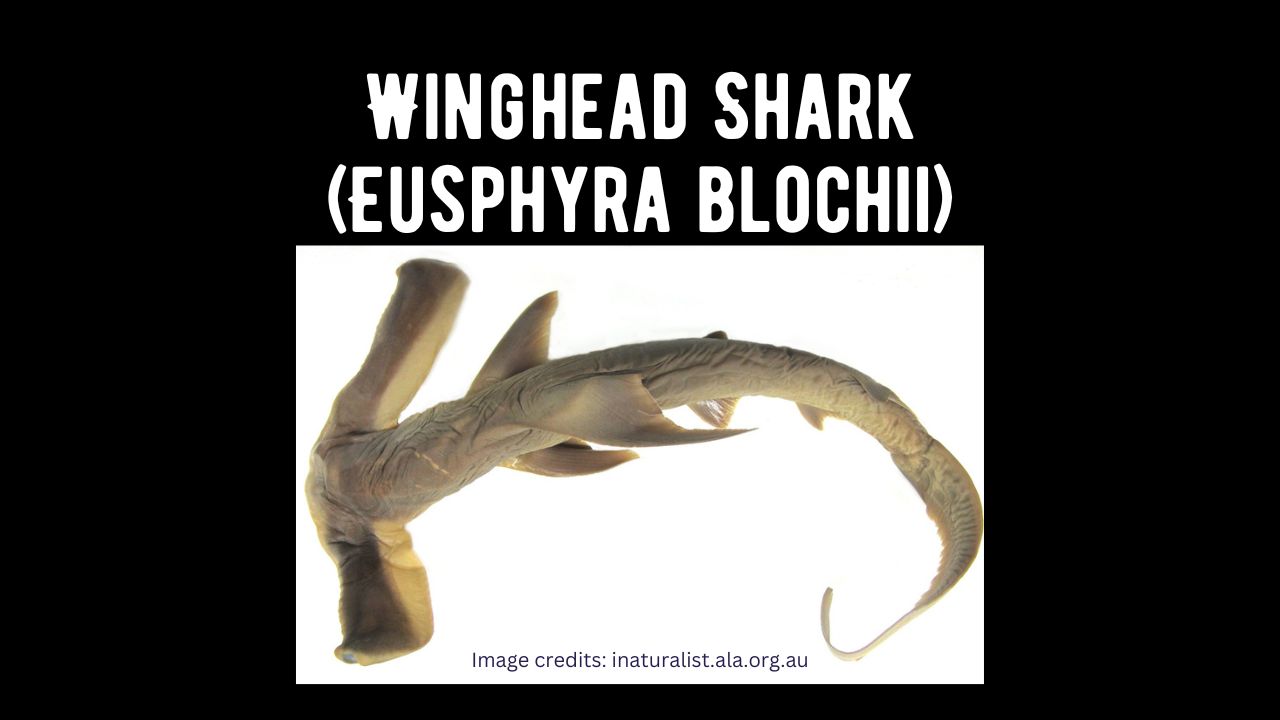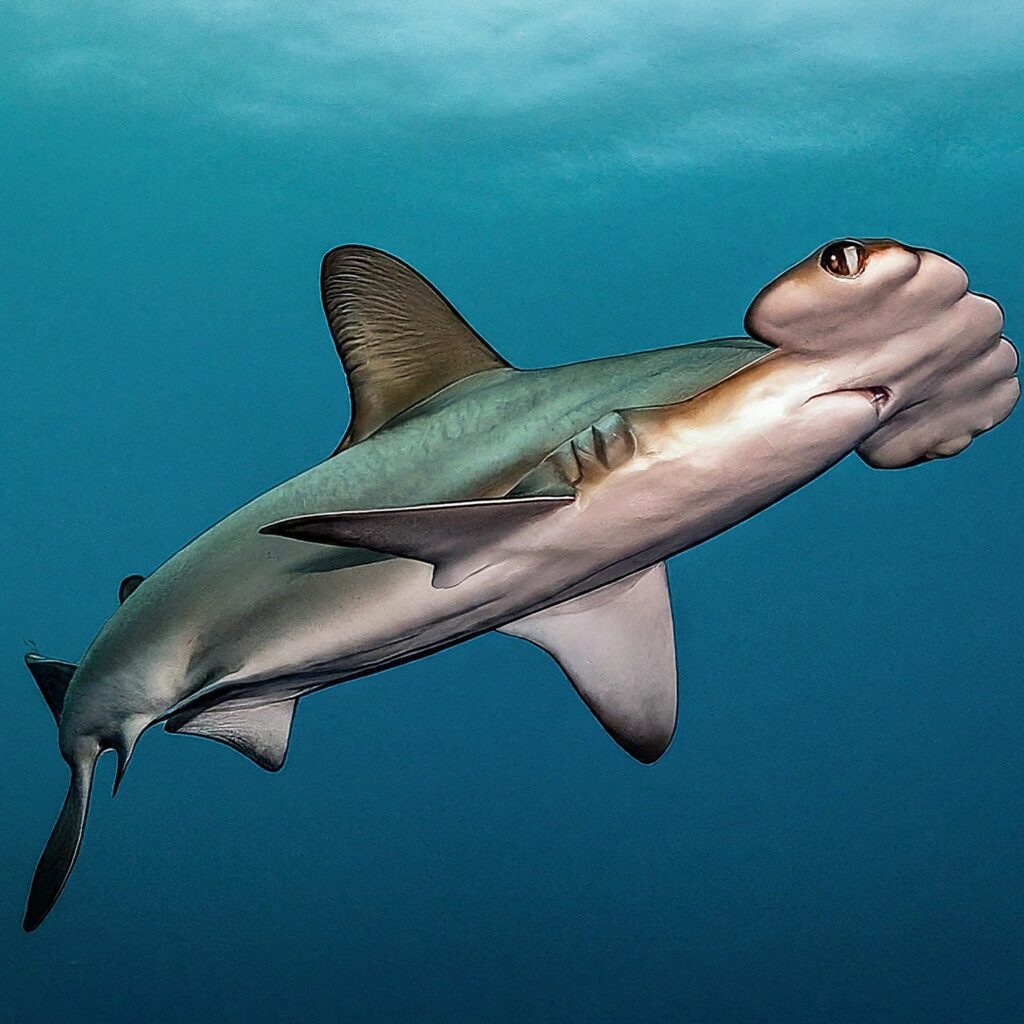
The Winghead Shark (Eusphyra blochii) is a fascinating and enigmatic species that belongs to the hammerhead shark family, Sphyrnidae. Unlike the more commonly known great hammerhead or scalloped hammerhead sharks, the winghead shark has a distinctive and unique hammer-shaped head, resembling two wings extending from either side.
Key Characteristics:
- Distinctive Head Shape: The most striking feature of the winghead shark is its hammer-shaped head, which is significantly wider than the head of other hammerhead species.
- Wingspan: The “wings” on either side of its head, known as cephalofoil, can have a span that is more than twice the width of its body.
- Eye Placement: The eyes are positioned at the tips of the cephalofoil, providing the shark with an expanded field of view.
Physical Appearance:
- Coloration: The winghead shark typically has a light brown to grayish-brown coloration on its upper body, while the underside is lighter.
- Size: Adults of this species can reach lengths of up to 3 meters (10 feet).
Habitat and Range:
- Tropical Waters: Winghead sharks prefer tropical and warm temperate coastal waters, and they are often found near continental shelves.
- Indo-Pacific Region: Their range spans the Indo-Pacific region, including the coasts of Southeast Asia, Northern Australia, and the Indian subcontinent.
Behavior and Diet:
- Feeding Habits: As with other hammerheads, the winghead shark’s unique head shape is believed to aid in detecting and capturing prey, including small fish, squid, and crustaceans.
- Social Behavior: These sharks are known to be solitary and are not commonly found in large groups.
Conservation Status:
- The winghead shark is classified as Near Threatened on the International Union for Conservation of Nature’s (IUCN) Red List.
- Threats include habitat degradation, fishing activities, and accidental capture in fishing gear.
Research and Conservation Efforts:
- Due to their relatively elusive nature, detailed studies on the biology and behavior of winghead sharks are limited.
- Conservation efforts focus on promoting sustainable fishing practices, protecting critical habitats, and raising awareness about the importance of these unique sharks in marine ecosystems.

Comparing Winghead, Hammerhead and Bonnethead Shark:
Sharks, with their diverse shapes and sizes, showcase remarkable adaptations to their environments. Among the intriguing varieties are the winghead shark, hammerhead shark, and bonnethead shark. Let’s delve into the distinctive features of each species and explore what sets them apart.
1. Winghead Shark (Eusphyra blochii): The Unique Aviator
Physical Characteristics:
- Head Shape: The most distinctive feature of the winghead shark is its hammer-shaped head, resembling two wings extending from either side.
- Size: Adults can reach lengths of up to 3 meters (10 feet).
- Coloration: Light brown to grayish-brown on the upper body, with a lighter underside.
Habitat and Behavior:
- Preferred Habitat: Tropical and warm temperate coastal waters, often near continental shelves.
- Feeding Habits: Solitary feeders, with a diet consisting of small fish, squid, and crustaceans.
- Conservation Status: Classified as Near Threatened due to habitat degradation and fishing activities.
2. Hammerhead Shark (Sphyrnidae): The Iconic Profile
Physical Characteristics:
- Head Shape: The hammerhead shark’s head has a distinctive T-shape, with eyes at the ends of the hammer.
- Varieties: Includes species like the great hammerhead, scalloped hammerhead, and smooth hammerhead.
- Size: Varied, with some species reaching lengths exceeding 6 meters (20 feet).
Habitat and Behavior:
- Global Distribution: Found in oceans worldwide, from coastal to deep waters.
- Feeding Habits: Known for their enhanced sensory perception, aiding in locating prey such as fish, rays, and crustaceans.
- Social Behavior: Often form schools during migration.
3. Bonnethead Shark (Sphyrna tiburo): The Smallest Hammerhead
Physical Characteristics:
- Head Shape: Smaller and more rounded than other hammerheads, resembling a shovel or bonnet.
- Size: Typically around 1.5 meters (5 feet) in length.
- Coloration: Gray to brown, with a lighter underside.
Habitat and Behavior:
- Preferred Habitat: Coastal waters, including bays, estuaries, and shallow tropical waters.
- Diet: Omnivorous, with a unique ability to digest seagrass along with small fish and crustaceans.
- Social Behavior: Often found in small groups.
Comparative Analysis:
Head Shapes:
- Winghead Shark: Uniquely wide, resembling two wings.
- Hammerhead Shark: T-shaped, with eyes positioned at the ends.
- Bonnethead Shark: Smaller and rounded, resembling a shovel or bonnet.
Size:
- Winghead Shark: Up to 3 meters (10 feet).
- Hammerhead Shark: Varied, with some species exceeding 6 meters (20 feet).
- Bonnethead Shark: Typically around 1.5 meters (5 feet).
Habitat:
- Winghead Shark: Tropical and warm temperate coastal waters.
- Hammerhead Shark: Global distribution, from coastal to deep waters.
- Bonnethead Shark: Coastal waters, including bays and estuaries.
Feeding Habits:
- Winghead Shark: Small fish, squid, and crustaceans.
- Hammerhead Shark: Varied diet, including fish, rays, and crustaceans.
- Bonnethead Shark: Omnivorous, consuming seagrass, small fish, and crustaceans.
Conclusion:
In conclusion, the winghead shark, hammerhead shark, and bonnethead shark each contribute to the diverse tapestry of shark species. Their unique adaptations highlight the incredible variety of forms that have evolved in response to different ecological niches and challenges in our oceans.
The winghead shark, with its distinctive appearance and behavior, adds to the rich tapestry of shark diversity. As with many shark species, understanding their biology and promoting conservation measures is essential to ensure the survival of these enigmatic creatures in our oceans.






